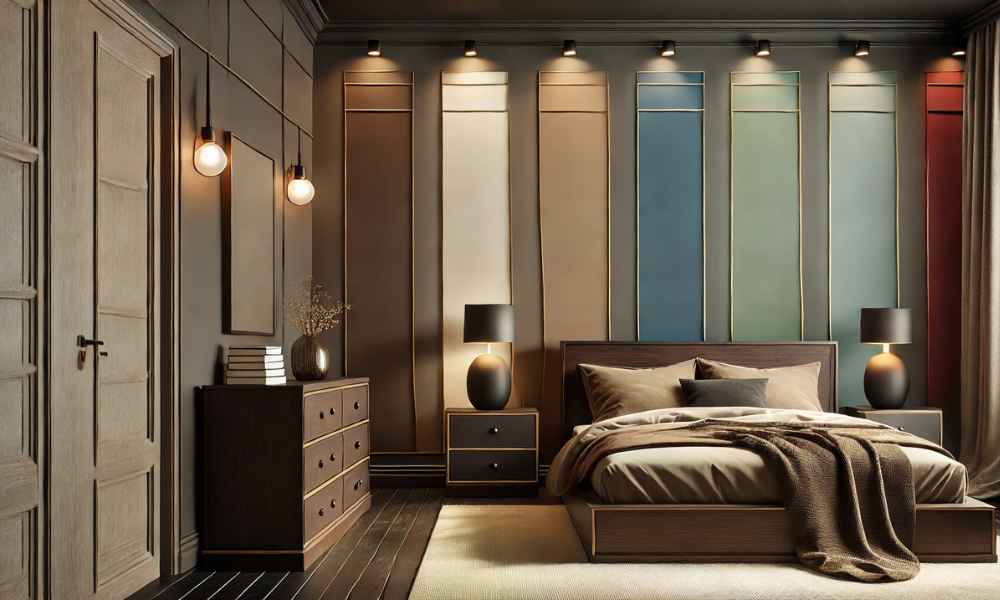Dark brown furniture has a rich, timeless appeal, bringing warmth and sophistication to a bedroom. However, choosing the right wall color to complement such furniture can be challenging. The right shade can enhance the beauty of dark brown furniture, creating a harmonious and visually appealing space. Whether you prefer neutral tones, earthy hues, soft pastels, or bold colors, selecting the perfect paint color will help balance the depth of dark wood while setting the right mood for your bedroom. Let’s explore different paint options to find the perfect match for dark brown furniture. Color Paint Goes With Dark Brown Furniture In Bedroom.
Understanding the Impact of Dark Brown Furniture on Bedroom Aesthetics
Dark brown furniture is a strong design element that naturally draws attention in a room. Its depth and richness can make a space feel cozy and grounded, but without the right wall color, it may also make the room feel heavy or outdated. Lighter colors create contrast and brighten the space, making it feel open and airy, while deeper hues offer a luxurious and sophisticated look. The key to choosing the right paint color is to find a balance—ensuring the walls enhance the furniture rather than compete with it. Additionally, lighting plays a significant role in how colors appear, so it’s important to consider natural and artificial light sources when selecting a paint shade.
Classic Neutrals That Compliment Dark Brown Furniture
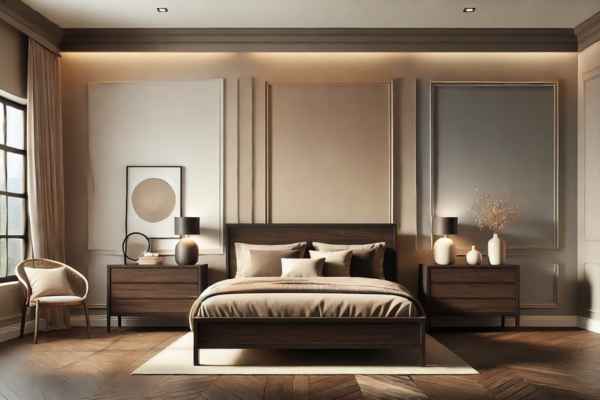
Neutral colors are a timeless and versatile choice when pairing with dark brown furniture. They create a clean and elegant look while allowing the rich tones of the furniture to stand out.
- Soft Whites: Shades of white, such as ivory, off-white, or warm white, create a bright and airy feel in the bedroom. White walls help dark furniture appear more defined while reflecting light, making the room feel more spacious.
- Warm Beiges: Beige tones with hints of caramel or taupe provide warmth to the space, creating a cozy and inviting atmosphere. This combination is perfect for those who want a balanced and comfortable setting without overwhelming contrast.
- Cool Grays: A light to medium gray adds a contemporary touch while maintaining an elegant feel. Cool-toned grays, such as dove gray or greige (a mix of gray and beige), blend well with dark brown furniture, creating a modern yet timeless aesthetic.
Earthy and Natural Tones for a Cozy Retreat
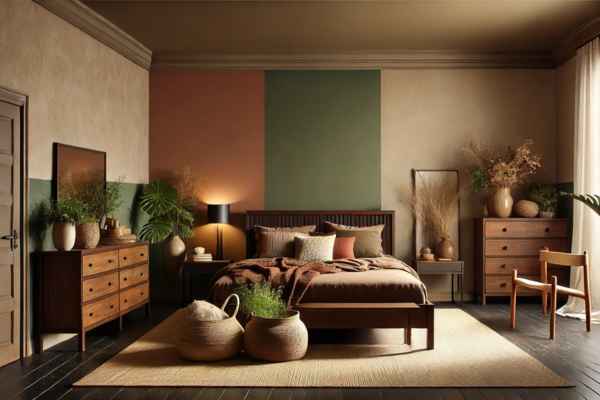
Earthy tones bring warmth and a connection to nature, making them an excellent choice for bedrooms with dark brown furniture. These shades create a soothing and grounded environment, perfect for relaxation.
- Olive Green: A muted olive or sage green pairs beautifully with dark brown, creating a nature-inspired retreat. This color evokes tranquility and freshness, making the bedroom feel like a peaceful escape.
- Terracotta or Burnt Orange: Warm, earthy hues like terracotta or burnt sienna add a rustic, inviting charm to a bedroom. These shades enhance the richness of dark wood and add depth to the space.
- Muted Taupe: Taupe combines elements of gray and brown, making it a perfect neutral with an earthy touch. It provides a soft contrast while maintaining warmth and cohesion with dark furniture.
Soft and Subtle Pastels for a Light and Airy Feel
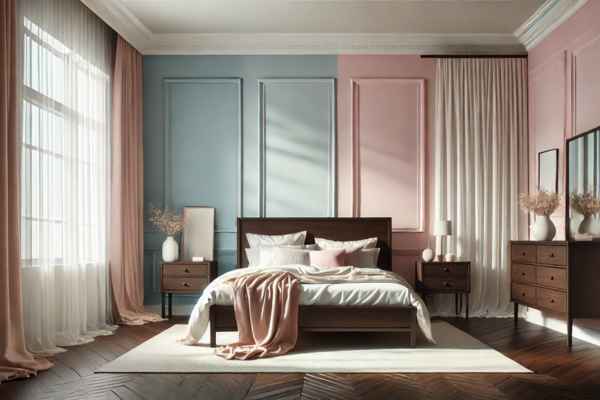
You prefer a more delicate and serene atmosphere, pastel shades are a fantastic choice. These colors soften the bold presence of dark brown furniture while maintaining a fresh and airy vibe.
- Powder Blue: A light, soft blue adds a calming and peaceful effect to the room. This color pairs well with dark furniture by providing a contrast that isn’t overpowering, creating a relaxed and serene ambiance.
- Blush Pink: A muted blush or dusty rose tone brings warmth and elegance to a bedroom with dark brown furniture. This unexpected yet sophisticated combination adds a gentle touch of color while keeping the space stylish and inviting.
- Lavender: A soft lavender or lilac creates a dreamy and tranquil setting. This shade works particularly well in well-lit rooms, enhancing the contrast between dark wood and pastel hues while maintaining a balanced aesthetic.
Bold and Dramatic Colors That Make a Statement
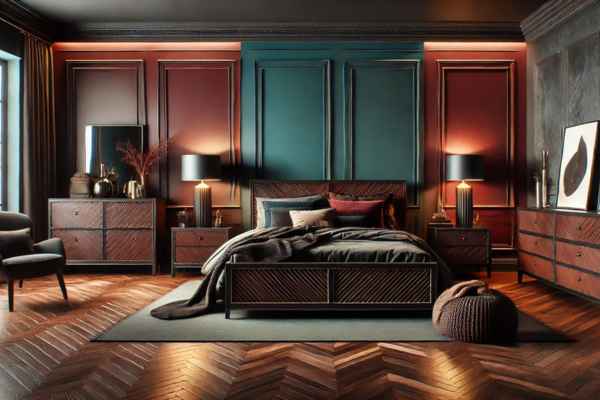
For those who love drama and sophistication, bold colors can create a striking contrast against dark brown furniture. These shades add depth, luxury, and a sense of personality to the bedroom.
- Deep Teal: A rich teal or peacock blue enhances the depth of dark brown furniture, creating a bold yet refined space. This color is ideal for adding a touch of luxury without overwhelming the room.
- Burgundy or Wine Red: Dark, warm reds like burgundy, oxblood, or wine red add a romantic and elegant touch. These deep hues create a rich and moody atmosphere, perfect for a cozy yet sophisticated bedroom.
- Charcoal or Black: For a modern and ultra-chic look, charcoal gray or even black walls create a dramatic contrast with dark brown furniture. This combination works best in rooms with ample natural light to prevent the space from feeling too enclosed.
Accent Walls: A Creative Way to Introduce Color
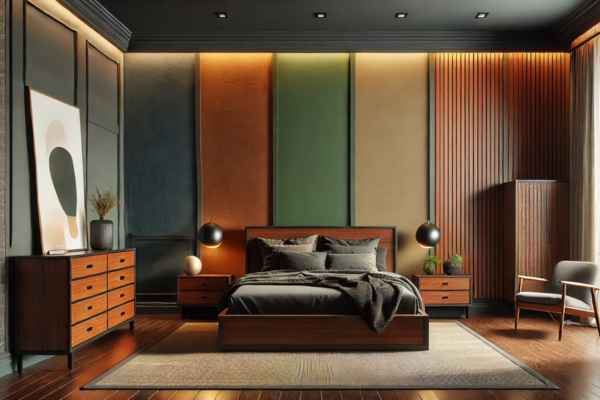
An accent wall can add personality and dimension to a bedroom with dark brown furniture without overwhelming the entire space. Instead of painting all four walls the same color, highlighting one wall with a complementary or contrasting shade can create a dynamic focal point.
For a subtle and sophisticated approach, a deep navy or forest green accent wall provides a bold contrast that enhances the richness of dark brown furniture. These colors bring depth and create a cozy, intimate setting. Alternatively, for a brighter and airier feel, a muted terracotta or mustard yellow accent wall adds warmth and pairs beautifully with the deep wood tones.
Accent walls are not limited to solid paint colors. Textured finishes, wallpaper, or even wooden paneling can elevate the look, making the space feel more curated and intentional. By strategically choosing the placement—often behind the bed or opposite a natural light source—the accent wall can dramatically enhance the room’s aesthetic.
Lighting and Its Effect on Paint Colors
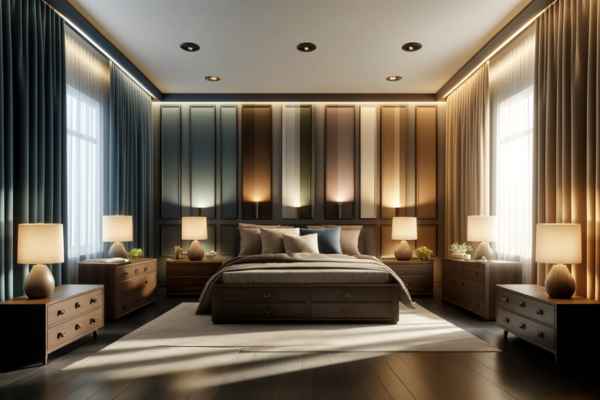
Lighting plays a crucial role in how paint colors appear in a bedroom, especially when paired with dark brown furniture. Natural daylight highlights undertones, making colors appear truer to their swatches, while artificial lighting—whether warm or cool—can alter the perception of color.
In rooms with abundant natural light, cooler shades like soft blues, greens, or grays maintain their crispness and contrast well with dark furniture. However, in bedrooms with limited sunlight, opting for warmer tones like creamy whites, warm beige, or even a muted gold can prevent the space from feeling too dark or heavy.
The type of artificial lighting also impacts color perception. Soft white or warm LED bulbs enhance the coziness of earth-toned or pastel walls, making them feel more inviting. On the other hand, bright white or daylight bulbs intensify the crispness of neutrals and cool-toned colors, creating a modern and airy ambiance. To ensure the perfect match, always test paint swatches under different lighting conditions before making a final decision.
Paint Finish Matters: Picking the Right Sheen
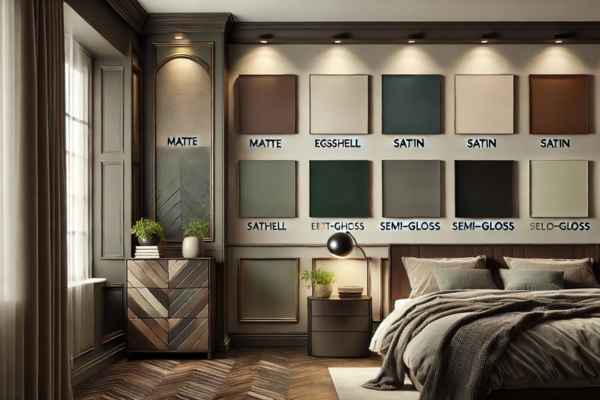
While color is important, the sheen or finish of the paint significantly influences the final look and feel of the room. Different finishes reflect light in various ways, affecting the overall atmosphere and maintenance of the walls.
- Matte Finish: Ideal for creating a soft, elegant look, matte finishes absorb light and minimize imperfections on the walls. This finish works well with muted tones like taupe, gray, or off-white, complementing dark brown furniture without adding glare.
- Eggshell and Satin Finishes: These provide a slight sheen, offering durability and ease of cleaning while maintaining a smooth appearance. They work well with deeper shades like olive green, rich teal, or warm beige, adding a hint of dimension to the walls.
- Semi-Gloss and Glossy Finishes: While these are typically used for trim and molding, they can be incorporated into walls for a more dramatic effect. Glossy finishes reflect light, making colors appear more vibrant—perfect for accent walls in bold hues like navy blue or charcoal.
Choosing the right finish depends on the desired aesthetic and practical needs. A matte or eggshell finish is best for a cozy, understated look, while a satin or semi-gloss finish enhances vibrancy and makes maintenance easier.
Creating Contrast with Trim and Ceiling Colors
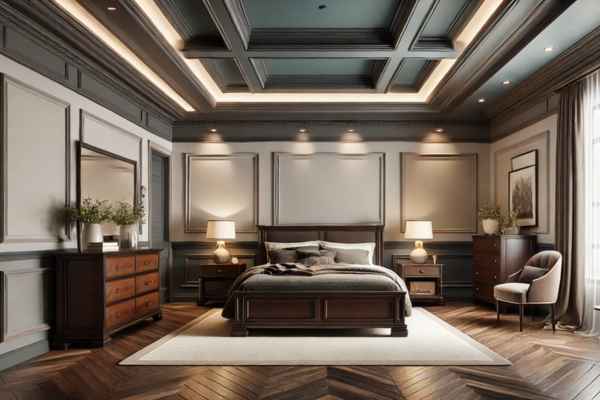
The trim and ceiling color play a vital role in tying the entire bedroom together, ensuring the wall color compliments dark brown furniture seamlessly. While some prefer a monochromatic approach, adding contrast through trim and ceiling colors enhances architectural details and creates a polished look.
- Crisp White Trim: White baseboards, door frames, and crown molding offer a clean, classic contrast against dark brown furniture. This combination brightens the space and defines the structure, making the room feel more spacious and refined.
- Matching Trim and Walls: Painting the trim the same color as the walls creates a seamless and modern aesthetic, making the space feel cohesive. This approach works well with soft neutrals like warm beige, greige, or muted pastels.
- Ceiling Colors: While traditional white ceilings keep the space open and airy, experimenting with light pastels or subtle grays can add an unexpected touch of style. In bedrooms with dark brown furniture, a soft taupe or pale blue ceiling creates depth without overpowering the space.
Using contrasting trim and ceiling colors not only enhances the overall aesthetic but also helps define the room’s architectural elements, ensuring the paint choice complements the furniture beautifully.
Choosing the Right Undertones for a Harmonious Look
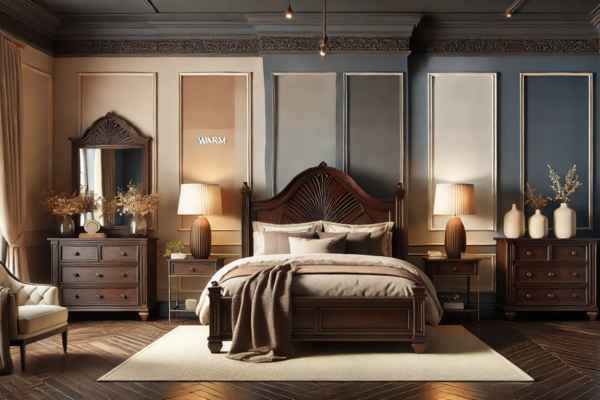
Undertones play a crucial role in how a color interacts with dark brown furniture. Even within the same color family, subtle differences in undertones can dramatically alter the room’s overall feel.
- Warm Undertones: If your dark brown furniture has reddish, golden, or espresso undertones, choosing a paint color with warm undertones—such as beige, soft cream, or warm taupe—helps create a cozy and inviting ambiance. Earthy shades like terracotta or muted mustard can also enhance the warmth of the wood.
- Cool Undertones: Dark brown furniture with cooler undertones, such as walnut or espresso with hints of gray, pairs beautifully with cool-toned wall colors like soft blue, slate gray, or even lavender. These shades contrast nicely while maintaining a sophisticated and airy feel.
- Neutral Undertones: If you’re unsure about warm or cool tones, go for a greige (gray + beige) or soft white with balanced undertones. These options work universally and adapt well to different lighting conditions.
By matching undertones correctly, the wall color and furniture will feel cohesive, ensuring that the space remains balanced rather than clashing or feeling disconnected.
Coordinating Paint Color with Bedding and Decor
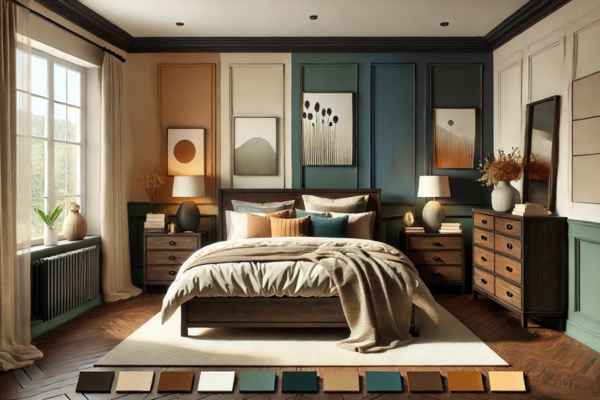
While wall color is a significant factor in room design, it should also blend seamlessly with bedding, curtains, rugs, and other decor elements. A well-coordinated color palette ties everything together, creating a visually pleasing and harmonious space.
- Monochromatic Approach: If you love a unified and soothing look, consider keeping the wall color, bedding, and decor in similar tones. For example, soft beige walls with cream bedding and light brown accents can create a seamless, elegant space.
- Contrast for Depth: For a more dynamic and layered look, contrast the wall color with bedding and accessories. If you choose a deep blue or green wall, balance it with light bedding, such as white or soft gray, to prevent the room from feeling too heavy.
- Accent Colors: Introducing accent colors through throw pillows, artwork, or curtains can add personality. If your walls are neutral, you can incorporate pops of color like burnt orange, mustard yellow, or teal in decorative pieces to enhance the overall design.
Coordinating paint colors with existing decor elements ensures that the entire bedroom looks thoughtfully designed rather than disjointed.
Mistakes to Avoid When Choosing Paint for Dark Brown Furniture
Selecting the wrong paint color can make a bedroom feel unbalanced or uninviting. Avoid these common pitfalls to achieve a well-coordinated and stylish space.
- Going Too Dark: Dark brown furniture already brings depth to the room, so using an overly dark wall color—such as deep brown or black—can make the space feel small and overwhelming unless balanced with ample lighting and bright decor.
- Ignoring Undertones: Not paying attention to warm or cool undertones can lead to clashing colors. Always test paint samples next to your furniture before finalizing the choice.
- Overloading with Brown Shades: While brown is a beautiful, grounding color, using too much of it (e.g., brown furniture, brown walls, and brown decor) can make the space feel monotonous and outdated. Incorporate contrast through lighter walls or accent colors.
- Skipping Paint Swatches: Colors look different under various lighting conditions, so always test swatches on the wall before committing. Natural and artificial light can affect how the paint interacts with the furniture.
Avoiding these mistakes will help create a balanced and stylish bedroom that feels comfortable and visually appealing.
Final Tips for Choosing the Perfect Paint Color
To ensure you choose the best wall color for your bedroom with dark brown furniture, keep these final tips in mind:
- Consider the Size of the Room: In smaller bedrooms, lighter colors help make the space feel open and airy, while in larger rooms, richer hues can add coziness and intimacy.
- Test Multiple Shades: Don’t rely on paint chips alone—apply sample swatches on different walls to see how they look in various lighting conditions throughout the day.
- Balance with Decor: Once you choose a wall color, make sure your bedding, curtains, and accessories work harmoniously to create a well-designed space.
- Incorporate Texture and Layers: If you’re using a neutral wall color, layer in different textures like wooden accents, woven rugs, or metallic elements to keep the room visually interesting.
Following these tips will help you achieve a bedroom that not only complements your dark brown furniture but also reflects your personal style.
Conclusion
Choosing the perfect paint color for a bedroom with dark brown furniture requires careful consideration of undertones, contrast, decor coordination, and lighting. Whether you opt for warm neutrals, soft pastels, bold statement colors, or earthy tones, the key is to create a balanced and harmonious space. By avoiding common mistakes and testing colors before committing, you can transform your bedroom into a stylish, inviting retreat that enhances the beauty of your dark brown furniture.
